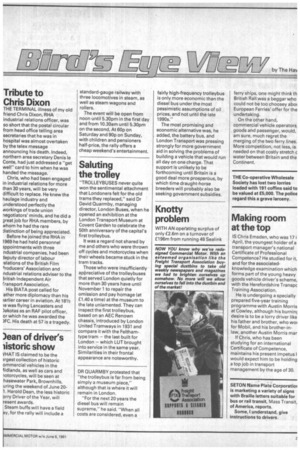Saluting the trolley
Page 31

If you've noticed an error in this article please click here to report it so we can fix it.
"TROLLEYBUSES never quite won the sentimental attachment that Londoners felt for the old trams they replaced," said Dr David Quarmby, managing director, London Buses, when he opened an exhibition at the London Transport Museum at Covent Garden to celebrate the 50th anniversary of the capital's first trolleybus.
It was a regard not shared by me and others who were thrown off cycles and motorcycles when their wheels became stuck in the tram tracks.
Those who were insufficiently appreciative of the trolleybuses that served London quietly for more than 30 years have until November 1 to repair the omission and pay homage (at £1.40 a time) at the museum to the late unlamented. They can inspect the first trolleybus, based on an AEC Renown chassis, introduced by London United Tramways in 1931 and compare it with the Felthamtype tram — the last built for London — which LUT brought into service in the same year. Similarities in their frontal appearance are noteworthy. fairly high-frequency trolleybus is only more economic than the diesel bus under the most pessimistic assumptions of oil prices, and not until the late 1990s."
The most promising and economic alternative was, he added, the battery bus, and London Transport was pressing strongly for more government aid in solving the problems of building a vehicle that would run all day on one charge. That support is unlikely to be forthcoming until Britain is a good deal more prosperous, by which time draught-horse breeders will probably also be seeking government subsidies.












































































































